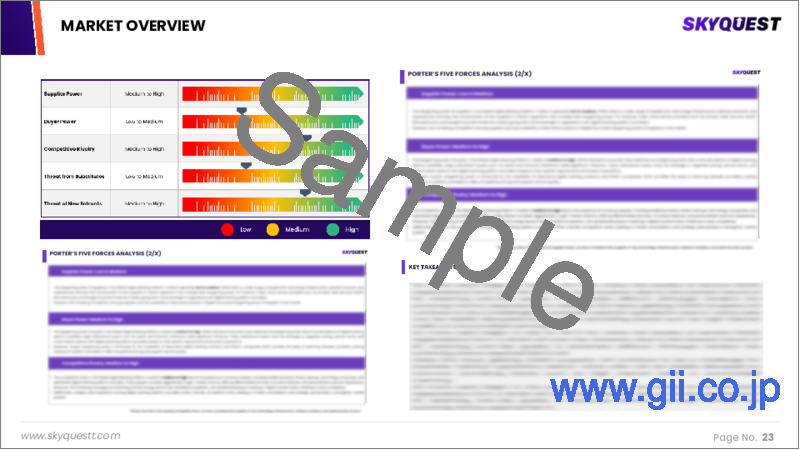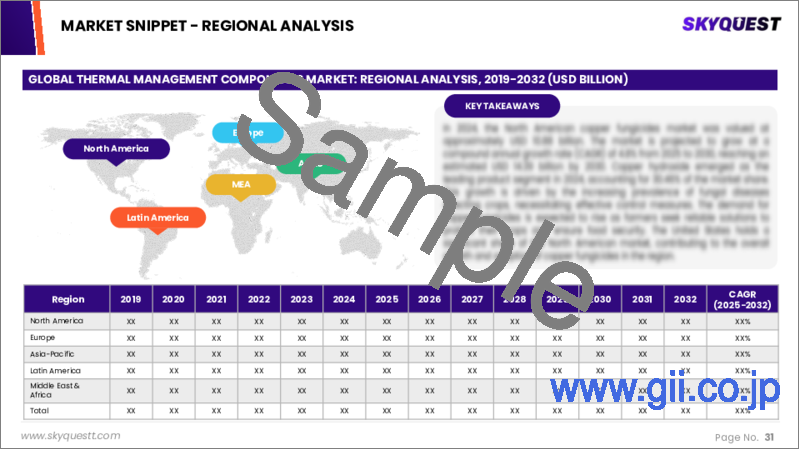|
|
市場調査レポート
商品コード
1673583
熱管理コンポーネントの市場規模、シェア、成長分析、材料タイプ別、デバイス別、サービス別、エンドユーザー産業別、地域別 - 産業予測、2025年~2032年Thermal Management Components Market Size, Share, and Growth Analysis, By Material Type (Adhesive Materials), By Device (Conduction Cooling Devices, Convection Cooling Devices), By Service, By End-User Industry, By Region - Industry Forecast 2025-2032 |
||||||
|
|||||||
| 熱管理コンポーネントの市場規模、シェア、成長分析、材料タイプ別、デバイス別、サービス別、エンドユーザー産業別、地域別 - 産業予測、2025年~2032年 |
|
出版日: 2025年03月01日
発行: SkyQuest
ページ情報: 英文 197 Pages
納期: 3~5営業日
|
全表示
- 概要
- 目次
熱管理コンポーネントの世界市場規模は2023年に124億7,000万米ドルとなり、予測期間(2025-2032年)のCAGRは9.9%で、2024年の137億米ドルから2032年には291億6,000万米ドルに成長する見通しです。
熱管理コンポーネント市場は、過熱を防ぐために効果的な温度調節が必要なスマートフォン、ラップトップ、タブレットなどの電子機器の需要急増に牽引され、力強い成長を遂げています。産業界が運用コストと環境への影響を削減するためにエネルギー効率の高いソリューションを優先する中、これらの部品に対するニーズが高まっています。さらに、バッテリーの性能を維持するために高度な温度管理を必要とする電気自動車やハイブリッド車の採用が増加していることも、需要を後押ししています。部品コストの高騰やエンドユーザーの認知度の低さといった課題は依然として残っているもの、小型化や熱管理システムへの人工知能の統合といった動向が拍車をかけ、市場は大きく拡大する見通しです。米国市場は今後数年間、持続可能なCAGRを維持すると予測されます。
目次
イントロダクション
- 調査の目的
- 調査範囲
- 定義
調査手法
- 情報調達
- 二次と一次データの方法
- 市場規模予測
- 市場の前提条件と制限
エグゼクティブサマリー
- 世界市場の見通し
- 供給と需要の動向分析
- セグメント別機会分析
市場力学と見通し
- 市場概要
- 市場規模
- 市場力学
- 促進要因と機会
- 抑制要因と課題
- ポーターの分析
主な市場の考察
- 重要成功要因
- 競合の程度
- 主な投資機会
- 市場エコシステム
- 市場の魅力指数(2024年)
- PESTEL分析
- マクロ経済指標
- バリューチェーン分析
- 価格分析
- 特許分析
- 規制分析
熱管理コンポーネント市場規模:材料タイプ別& CAGR(2025-2032)
- 市場概要
- 接着剤
- テープ
- フィルム
- 熱伝導フィルム
- 導電性フィルム
- 接着剤液
- 熱硬化液
- 室温硬化液
- 非接着性材料
熱管理コンポーネント市場規模:デバイス別& CAGR(2025-2032)
- 市場概要
- 伝導冷却装置
- ウェッジロック
- ポッティング材
- 対流冷却装置
- ヒートシンク
- 帽子スプレッダー
- 強制空気冷却装置と自然冷却装置
- ヒートポンプ
- 高度な冷却装置
- 直接浸漬冷却
- マイクロチャネル冷却
- コールドプレート
- その他
- 極低温冷却装置
- 冷媒冷却装置
- スプレークーラー
- ハイブリッド冷却装置
- エレクトロウェッティングデバイス
- スポットクーラー
- 蒸気チャンバー
- コンパクト熱交換器
- 熱電冷却装置
- その他
- ジェットインピンジメントクーラー
- ヒートスーパーコン
熱管理コンポーネント市場規模:サービス別& CAGR(2025-2032)
- 市場概要
- 据え付けとキャリブレーション
- 最適化とアフターセールスサポート
熱管理コンポーネント市場規模:エンドユーザー業界別& CAGR(2025-2032)
- 市場概要
- 家電
- ノートパソコンとコンピューター
- オーディオアンプ部品
- 電源ユニット
- ゲームデバイス
- スマートフォン
- 家電製品(テレビ冷蔵庫洗濯機など)
- サーバーとデータセンター
- シングルラック
- マルチラック
- 自動車
- バッテリー熱管理システム
- エンジン制御熱管理システム
- 廃熱回収・排出削減システム
- ブレーキおよびサスペンション冷却システム
- シート加熱・冷却システム
- 自動車照明システム
- 航空宇宙および防衛
- 企業
- ヘルスケア
- 大型インフラ設備
- ポータブル機器
- その他のエンドユーザー産業
- 製造業
- 小売
- 輸送エンドユーザー産業
熱管理コンポーネント市場規模& CAGR(2025-2032)
- 北米
- 米国
- カナダ
- 欧州
- ドイツ
- スペイン
- フランス
- 英国
- イタリア
- その他欧州地域
- アジア太平洋地域
- 中国
- インド
- 日本
- 韓国
- その他アジア太平洋地域
- ラテンアメリカ
- ブラジル
- その他ラテンアメリカ地域
- 中東・アフリカ
- GCC諸国
- 南アフリカ
- その他中東・アフリカ
競合情報
- 上位5社の比較
- 主要企業の市場ポジショニング(2024年)
- 主な市場企業が採用した戦略
- 最近の市場動向
- 企業の市場シェア分析(2024年)
- 主要企業の企業プロファイル
- 企業の詳細
- 製品ポートフォリオ分析
- 企業のセグメント別シェア分析
- 収益の前年比比較(2022-2024)
主要企業プロファイル
- Vertiv(United States)
- Johnson Controls(Ireland)
- BELIMO Holding AG(Switzerland)
- Daikin Industries, Ltd.(Japan)
- Spirax Group plc(United Kingdom)
- MAHLE GmbH(Germany)
- Honeywell International Inc.(United States)
- Schneider Electric SE(France)
- Eaton Corporation plc(Ireland)
- Parker-Hannifin Corporation(United States)
- NIBE Industrier AB(Sweden)
- Modine Manufacturing Company(United States)
- Laird Thermal Systems(United States)
- DENSO Corporation(Japan)
- Mitsubishi Electric Corporation(Japan)
- Sanhua Holding Group Co., Ltd.(China)
- Boyd Corporation(United States)
- Advanced Cooling Technologies, Inc.(United States)
- Aavid Thermalloy LLC(United States)
- Lytron Inc.(United States)
結論と提言
Global Thermal Management Components Market size was valued at USD 12.47 billion in 2023 and is poised to grow from USD 13.7 billion in 2024 to USD 29.16 billion by 2032, growing at a CAGR of 9.9% during the forecast period (2025-2032).
The thermal management components market is experiencing robust growth, driven by the surge in demand for electronic devices like smartphones, laptops, and tablets, which necessitate effective temperature regulation to prevent overheating. As industries prioritize energy-efficient solutions to reduce operational costs and environmental impact, the need for these components has intensified. Demand is further bolstered by the rising adoption of electric and hybrid vehicles that require advanced thermal management to maintain battery performance. Although challenges such as high component costs and limited end-user awareness persist, the market is set for significant expansion, spurred by trends like miniaturization and the integration of artificial intelligence in thermal management systems. The US market is projected to maintain a sustainable CAGR in the coming years.
Top-down and bottom-up approaches were used to estimate and validate the size of the Global Thermal Management Components market and to estimate the size of various other dependent submarkets. The research methodology used to estimate the market size includes the following details: The key players in the market were identified through secondary research, and their market shares in the respective regions were determined through primary and secondary research. This entire procedure includes the study of the annual and financial reports of the top market players and extensive interviews for key insights from industry leaders such as CEOs, VPs, directors, and marketing executives. All percentage shares split, and breakdowns were determined using secondary sources and verified through Primary sources. All possible parameters that affect the markets covered in this research study have been accounted for, viewed in extensive detail, verified through primary research, and analyzed to get the final quantitative and qualitative data.
Global Thermal Management Components Market Segments Analysis
Global Thermal Management Components Market is segmented by Material Type, Device, Service, End-User Industry and region. Based on Material Type, the market is segmented into Adhesive Materials. Based on Device, the market is segmented into Conduction Cooling Devices, Convection Cooling Devices, Advanced Cooling Devices and Hybrid Cooling Devices. Based on Service, the market is segmented into Installation & Calibration and Optimization & Post-Sales Support. Based on End-User Industry, the market is segmented into Consumer Electronics, Servers & Data Centers, Automotive, Aerospace & Defense, Enterprises, Healthcare and Other End-User Industries. Based on region, the market is segmented into North America, Europe, Asia Pacific, Latin America and Middle East & Africa.
Driver of the Global Thermal Management Components Market
The increasing use of electronic devices such as smartphones, tablets, laptops, gaming consoles, and automotive electronics is significantly fueling the demand for thermal management components. As technology advances and these devices become more powerful yet compact, efficient heat dissipation is essential to prevent overheating and maintain optimal performance. This necessity for reliable thermal management solutions is a key driver in the global market, as manufacturers strive to enhance the efficiency and longevity of their electronic products while ensuring user satisfaction and safety. Consequently, the expansion of the electronic device market directly correlates with the growth of thermal management components.
Restraints in the Global Thermal Management Components Market
One significant restraint in the Global Thermal Management Components market is the high cost associated with advanced thermal management solutions, like premium heat sinks and thermoelectric coolers. These expensive components may deter adoption, particularly in markets that are sensitive to pricing. Consequently, manufacturers face the challenge of striking a balance between performance and cost-effectiveness in their thermal management offerings to satisfy evolving market requirements. This financial barrier can hinder the widespread implementation of innovative solutions, as businesses must weigh the benefits of enhanced thermal management against their budget constraints in competitive environments.
Market Trends of the Global Thermal Management Components Market
The Global Thermal Management Components market is witnessing a notable shift towards the increasing adoption of liquid cooling solutions, driven by the need for enhanced thermal efficiency in high-power electronic applications. Liquid cooling systems, including liquid heat exchangers and cold plates, are becoming increasingly favored over traditional air-cooling methods due to their superior heat dissipation capabilities. This trend is particularly prominent in sectors such as data centers and electric vehicle battery cooling, where efficient thermal management is crucial for achieving higher power densities. As industries seek to optimize performance and reliability, liquid cooling technologies are set to become a dominant force in the thermal management landscape.
Table of Contents
Introduction
- Objectives of the Study
- Scope of the Report
- Definitions
Research Methodology
- Information Procurement
- Secondary & Primary Data Methods
- Market Size Estimation
- Market Assumptions & Limitations
Executive Summary
- Global Market Outlook
- Supply & Demand Trend Analysis
- Segmental Opportunity Analysis
Market Dynamics & Outlook
- Market Overview
- Market Size
- Market Dynamics
- Drivers & Opportunities
- Restraints & Challenges
- Porters Analysis
- Competitive rivalry
- Threat of substitute
- Bargaining power of buyers
- Threat of new entrants
- Bargaining power of suppliers
Key Market Insights
- Key Success Factors
- Degree of Competition
- Top Investment Pockets
- Market Ecosystem
- Market Attractiveness Index, 2024
- PESTEL Analysis
- Macro-Economic Indicators
- Value Chain Analysis
- Pricing Analysis
- Patent Analysis
- Regulatory Analysis
Global Thermal Management Components Market Size by Material Type & CAGR (2025-2032)
- Market Overview
- Adhesive Materials
- Tapes
- Films
- Thermally Conductive Films
- Electrically Conductive Films
- Adhesive Liquids
- Heat Cure Liquids
- Room Temperature Cure Liquids
- Non-adhesive Materials
Global Thermal Management Components Market Size by Device & CAGR (2025-2032)
- Market Overview
- Conduction Cooling Devices
- Wedge Locks
- Potting Materials
- Convection Cooling Devices
- Heat Sinks
- Hat Spreaders
- Forced Air and Natural Cooling Devices
- Heat Pumps
- Advanced Cooling Devices
- Direct Immersion Cooling
- Microchannel Cooling
- Cold Plates
- Others
- Cryogenic Cooling Devices
- Refrigerant Cooling Devices
- Spray Coolers
- Hybrid Cooling Devices
- Electrowetting Devices
- Spot Coolers
- Vapor Chambers
- Compact Heat Exchangers
- Thermoelectric Cooling Devices
- Others
- Jet Impingement Coolers
- Heat Supercon
Global Thermal Management Components Market Size by Service & CAGR (2025-2032)
- Market Overview
- Installation & Calibration
- Optimization & Post-Sales Support
Global Thermal Management Components Market Size by End-User Industry & CAGR (2025-2032)
- Market Overview
- Consumer Electronics
- Laptops and Computers
- Audio Amplifier Components
- Power Supply Units
- Gaming Devices
- Smartphones
- Home Appliances (TV Sets, Fridges, Washing Machines, Etc.)
- Servers & Data Centers
- Single Racks
- Multi Racks
- Automotive
- Battery Thermal Management Systems
- Engine Control Thermal Management Systems
- Waste Heat Recovery and Emission Reduction Systems
- Brake and Suspension Cooling Systems
- Seat Heating and Cooling Systems
- Automotive Lighting Systems
- Aerospace & Defense
- Enterprises
- Healthcare
- Large Infrastructure Equipment
- Portable Equipment
- Other End-User Industries
- Manufacturing
- Retail
- Transportation End-Use Industries
Global Thermal Management Components Market Size & CAGR (2025-2032)
- North America (Material Type, Device, Service, End-User Industry)
- US
- Canada
- Europe (Material Type, Device, Service, End-User Industry)
- Germany
- Spain
- France
- UK
- Italy
- Rest of Europe
- Asia Pacific (Material Type, Device, Service, End-User Industry)
- China
- India
- Japan
- South Korea
- Rest of Asia-Pacific
- Latin America (Material Type, Device, Service, End-User Industry)
- Brazil
- Rest of Latin America
- Middle East & Africa (Material Type, Device, Service, End-User Industry)
- GCC Countries
- South Africa
- Rest of Middle East & Africa
Competitive Intelligence
- Top 5 Player Comparison
- Market Positioning of Key Players, 2024
- Strategies Adopted by Key Market Players
- Recent Developments in the Market
- Company Market Share Analysis, 2024
- Company Profiles of All Key Players
- Company Details
- Product Portfolio Analysis
- Company's Segmental Share Analysis
- Revenue Y-O-Y Comparison (2022-2024)
Key Company Profiles
- Vertiv (United States)
- Company Overview
- Business Segment Overview
- Financial Updates
- Key Developments
- Johnson Controls (Ireland)
- Company Overview
- Business Segment Overview
- Financial Updates
- Key Developments
- BELIMO Holding AG (Switzerland)
- Company Overview
- Business Segment Overview
- Financial Updates
- Key Developments
- Daikin Industries, Ltd. (Japan)
- Company Overview
- Business Segment Overview
- Financial Updates
- Key Developments
- Spirax Group plc (United Kingdom)
- Company Overview
- Business Segment Overview
- Financial Updates
- Key Developments
- MAHLE GmbH (Germany)
- Company Overview
- Business Segment Overview
- Financial Updates
- Key Developments
- Honeywell International Inc. (United States)
- Company Overview
- Business Segment Overview
- Financial Updates
- Key Developments
- Schneider Electric SE (France)
- Company Overview
- Business Segment Overview
- Financial Updates
- Key Developments
- Eaton Corporation plc (Ireland)
- Company Overview
- Business Segment Overview
- Financial Updates
- Key Developments
- Parker-Hannifin Corporation (United States)
- Company Overview
- Business Segment Overview
- Financial Updates
- Key Developments
- NIBE Industrier AB (Sweden)
- Company Overview
- Business Segment Overview
- Financial Updates
- Key Developments
- Modine Manufacturing Company (United States)
- Company Overview
- Business Segment Overview
- Financial Updates
- Key Developments
- Laird Thermal Systems (United States)
- Company Overview
- Business Segment Overview
- Financial Updates
- Key Developments
- DENSO Corporation (Japan)
- Company Overview
- Business Segment Overview
- Financial Updates
- Key Developments
- Mitsubishi Electric Corporation (Japan)
- Company Overview
- Business Segment Overview
- Financial Updates
- Key Developments
- Sanhua Holding Group Co., Ltd. (China)
- Company Overview
- Business Segment Overview
- Financial Updates
- Key Developments
- Boyd Corporation (United States)
- Company Overview
- Business Segment Overview
- Financial Updates
- Key Developments
- Advanced Cooling Technologies, Inc. (United States)
- Company Overview
- Business Segment Overview
- Financial Updates
- Key Developments
- Aavid Thermalloy LLC (United States)
- Company Overview
- Business Segment Overview
- Financial Updates
- Key Developments
- Lytron Inc. (United States)
- Company Overview
- Business Segment Overview
- Financial Updates
- Key Developments





